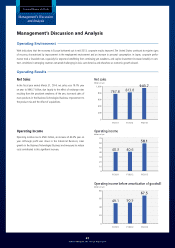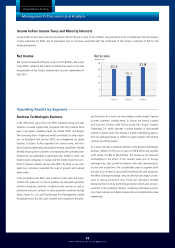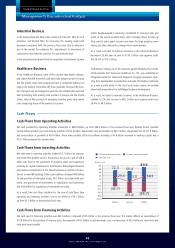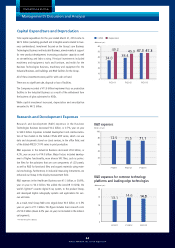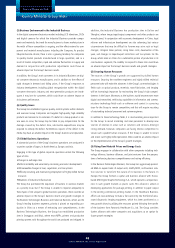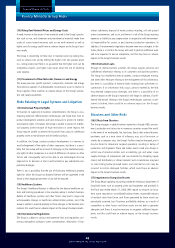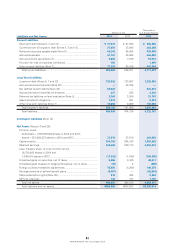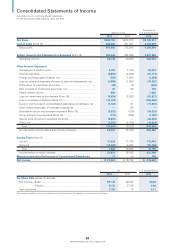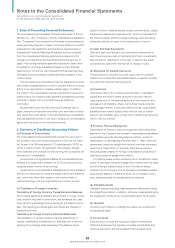Konica Minolta 2014 Annual Report Download - page 49
Download and view the complete annual report
Please find page 49 of the 2014 Konica Minolta annual report below. You can navigate through the pages in the report by either clicking on the pages listed below, or by using the keyword search tool below to find specific information within the annual report.
48
KONICA MINOLTA, INC. Annual Report 2014
Financial Review and Data
Konica Minolta Group Risks
(5) Business Environment in the Industrial Business
In the digital consumer electronics market including LCD televisions, DVDs
and digital cameras for which the Industrial Business provides compo-
nents and materials, the trend for manufacturers to lower market prices in
the midst of fierce competition is ongoing, and the effects extend to com-
ponent and material manufacturers including the Company. As product
lifecycles become shorter, there is also a growing tendency for companies
to quickly market products manufactured in large quantities, and as a
result of market competition, rapid and extreme fluctuations in supply and
demand in conjunction with production adjustments could have an
adverse impact on the Group’s business results.
In addition, the Group’s main customers in its Industrial Business are digi-
tal consumer electronics manufacturers, and in addition to the effects of
rapid changes in demand and falling prices, if the Group’s responses to
industry developments including global reorganization within the digital
consumer electronics industry and next-generation products are inade-
quate, it may lose its customers, which could have an adverse impact on
its business performance.
(6) Quality Issues
The Group has established rigorous quality control systems within domestic
and overseas Group Companies and supplies high-quality, high-reliability
products and services to its customers. If a defect in a Group product or ser-
vice were to occur, the Group may be liable to pay compensation for the
damage caused by the defect. Also, substantial expenditures may be
required to remedy the defect. Furthermore, reports of the defect in the
media may have an adverse impact on the Group’s business and reputation.
(7) Global Business Operations
A substantial portion of the Group’s business operations are conducted in
countries outside of Japan, in North America, Europe, and Asia.
Engaging in this type of global corporate operations entails the following
types of risks.
•Changesinexchangerates
•Politicalinstabilityanduncertaintyconcerningeconomicdevelopments
•Unforeseeablechangesinlaws,regulations,andtaxsystems
•Difcultyrecruitingandmaintainingemploymentofhighlyskilledhuman
resources
•Weaknessofindustrialinfrastructure
The Group has positioned the expansion of business in overseas markets
as a priority issue, but if the Group is unable to respond adequately to
these types of risk unique to global business operations, there could be an
adverse impact on the Group’s business results and growth strategies. In
the Business Technologies Business and Industrial Business, which are the
Group’s leading business segments, priority is placed on expanding pro-
duction in China as a means of enhancing cost competitiveness. In the
Business Technologies Business, the Group has established production
sites in Dongguan and Wuxi, where most MFPs, printers and production
printing systems sold throughout the world are produced and shipped. In
addition, the Industrial Business has production sites in Dalian and
Shanghai,whereimageinput/outputcomponentsandotherproductsare
manufactured. In conjunction with economic development in China, legal
reforms and infrastructure development are also advancing, but various
circumstances that may be difficult to foresee may arise such as legal
changes, stringent labor policies, rising labor costs, devaluation of the
yuan,andchangesinimport/exportrestrictionsandtaxsystems.Forthe
Group, which relies on China for a substantial portion of production in its
core business segments, the inability to respond to these risks could have
an adverse impact on the Group’s business results and growth strategies.
(8) Securing Human Resources
The sources of the Group’s growth are supported by skilled human
resources. Securing the excellent engineers and highly skilled technical
personnel who will make the advances in the Group’s core technologies in
fields such as optical products, materials, nano-fabrication, and imaging
will be increasingly important for maintaining the Group’s high competi-
tiveness in the future. Moreover, as the business world becomes ever more
digital and networked, reinforcing capabilities in information and commu-
nications technology fields such as software and control is a pressing
issue for the Group to remain competitive, and this will require recruiting
of outstanding technical personnel and system engineers.
In addition to these technology fields, it is also becoming more important
for the Group to recruit marketing and sales personnel to develop new
sources of revenue in areas such as solutions and services. Amongst
strong demand, however, companies are facing intense competition to
secure such capable human resources. If the Group is unable to recruit
and retain such highly skilled personnel, there could be an adverse impact
on the implementation of the Group’s growth strategies.
(9) Rising Raw Material Prices and Energy Costs
The Group engages in collaboration with other companies including tech-
nology alliances, business alliances, and joint ventures from the perspec-
tives of enhancing business competitiveness and raising efficiency.
In the Business Technologies Business, the Group has aggressively promot-
ed M&A to expand sales of output units, chiefly MFPs, and business solu-
tion services to transform the nature of its business in the future. In
Europe, the Group formed a capital and business alliance with France-
based MGI Digital Graphic Technology S.A., which operates a unique busi-
ness in such growth markets as plastic cards. This alliance is aimed at
developing applications for package printing, in addition to paper output
in the existing commercial printing market. In the Healthcare Business,
efforts are now underway to make a full scale entry into the field of ultra-
sound diagnostic imaging equipment, which has been positioned as a
new growth driver, by utilizing the resources gained following the transfer
of the business from Panasonic Healthcare Co., Ltd. The Group considers
further alliances with other companies and acquisitions as an option for
future growth strategies.





